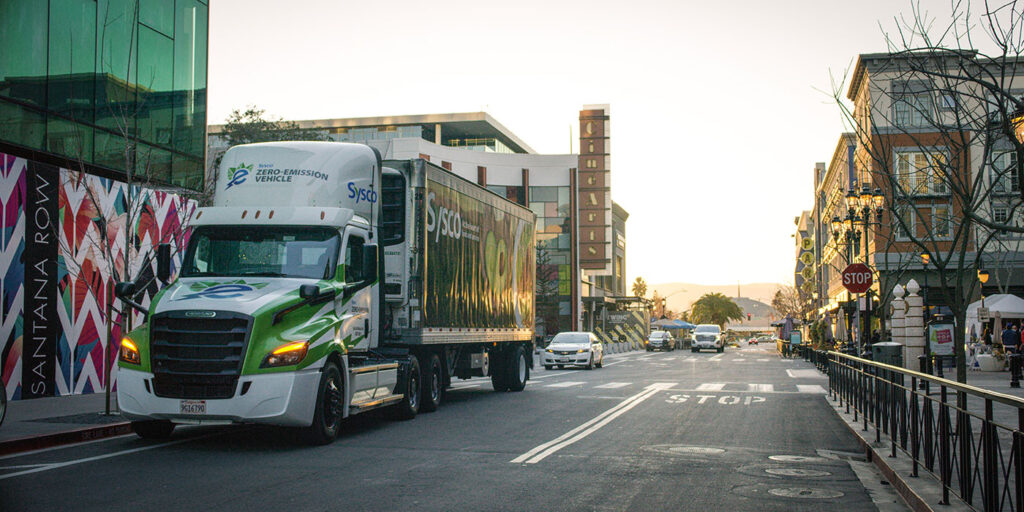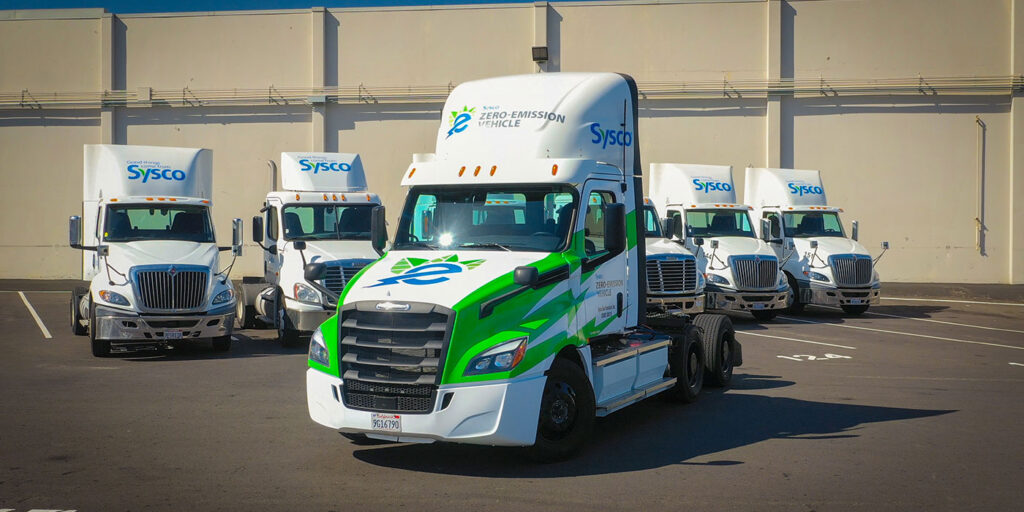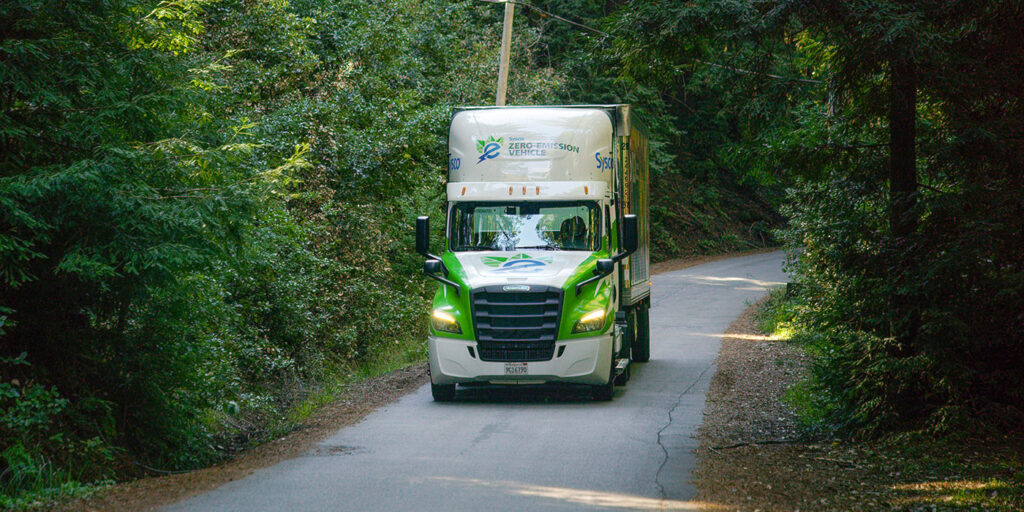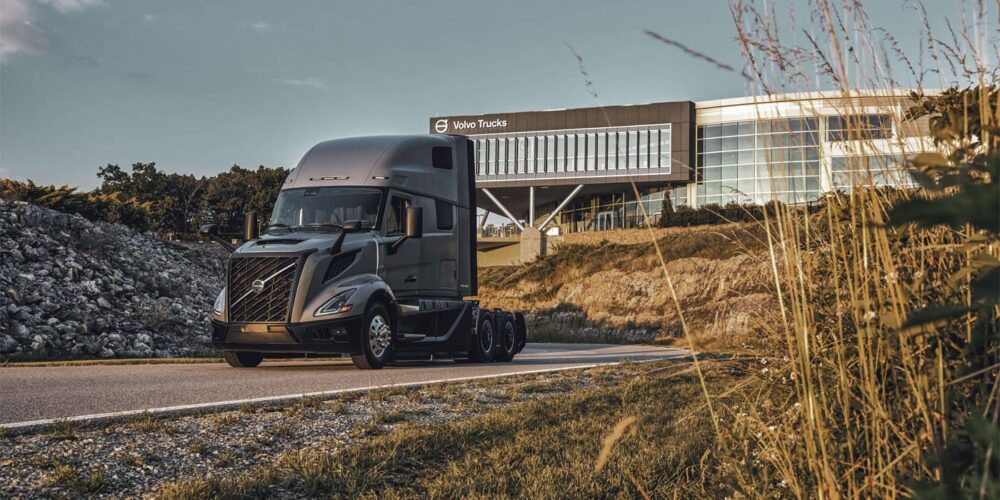It’s a staggering number of electric trucks: 800 Class 8 battery electric tractors. While many forward-thinking fleets are piloting one electric truck or planning for tens of electric trucks in the next several years, Sysco Corp. signed a letter of intent earlier this year to deploy up to nearly 800 battery electric Freightliner eCascadia Class 8 tractors by 2026. Before you pick your jaw up off of the floor, Marie Robinson, chief supply chain officer, Sysco Corp., shared the fleet’s true electric vehicle target.
“Our actual stated public goal is to electrify 35% of our U.S. broadline fleet; so it’s more like 2,500 electric trucks by 2030,” Robinson explained.
That’s a lot of electric trucks. Yet, given where we are in the fourth quarter of 2022–the equipment isn’t in question. Freightliner unveiled its production model eCascadia earlier this year, sporting 320-470 HP, a typical range of 230 miles (depending on vehicle configuration), multiple battery options and maximum capacity of almost 440 kWh. None of those specs came as a surprise to Sysco because they were on the front lines of the eCascadia’s development, working hand-in-hand with Daimler Truck North America. After all, you don’t set out to field 2,500 electric tractors overnight. You start early. Sysco started four years ago.
“At that point in time, there were a lot of people just talking about electric trucks. There was a lot of electric buzz when Tesla announced its truck. So Sysco started going to the OEMs and asking, ‘What are you working on? Can we sit down with you? Can we see the plans?’” Robinson said. “Over the course of that first couple of years, it became really apparent to them that Daimler Truck was the one that was the most organized, the most committed to deliver electric trucks in the industry. They felt like they were really going to get across the finish line first and so they began to pursue a partnership with them.
“About three years ago, that partnership had evolved to the point that we were literally on the design floor with them talking about the tractor itself–the specific demands and our use cases. That led to a year ago, when the first test vehicle was put on the road in Northern California so that we could further refine the specifications before we issued our first production order.”
Sysco put the Freightliner eCascadia through its paces in Northern California because there are hills and valleys and humidity that eventually burns off and gives way to cool, dry evenings. It had nearly every terrain and climate the first round of electric trucks would face.
“It was really important to us to find out what was going to happen when you were on a mountainous route versus an urban route with a fully loaded trailer for food deliveries,” Robinson said. “For our planning purposes, for the first few years, we are only assigning electric trucks to routes that are less than 125 miles.
“About a third of our daily routes are 125 miles or less, which means that 35% goal actually works for us,” she continued. “All of this kind of came together in a way that had as much magic or art to it as it did science, and we were able to bring those pieces together.”
Back to that amazing and clearly accurate earlier statement: Electric trucks aren’t the unknown variable in the electrification equation. With that as a given, and the answer to the equation supplied by the truck’s application, then–whether you’re trying to field 800 electric trucks or even one electric truck– we’re all solving for Y. And Y is charging infrastructure.
Solving the electrification equation
Here comes the caveat that every charging infrastructure is going to be different. Unique variables, unexpected wrinkles in the installation and ROI calculus that will be only applicable to your fleet. That said, Robinson gave us a crash course in how Sysco is tackling its own electric truck charging challenges. It starts with asking questions.
- Is there enough utility power going into a site to actually install the electric charging infrastructure?
- What are the most likely charging sites to target in what order?
- How difficult is it to install at that location?
- How mature is the state itself in things like permitting and licensing?
The questions will be the same for every fleet, but answers will vary. That last question, in particular, is being asked more and more and that particular answer can be frustrating if you’re a fleet that is gung-ho for battery electric trucks.
“We’re not as concerned right now with grants, even though they’re wonderful and we’re certainly going to do what we can do to get our fair share, because we believe we’re leaders in that space,” Robinson said, noting that state permitting and licensing is a big challenge. “That’s why, right now, we’re deep into California, but we’re quickly diversifying to other states, Colorado, Texas, New York and Maryland for example, which has come out of nowhere as a front runner. We’re looking at states that look electric charger installation friendly.”
As Sysco works at building out its 14 currently planned charging sites (that will take anywhere from 18 to 24 months to get powered up) it’s not sitting on its hands waiting. It will still put electric trucks to work, using a charging method that is getting more and more consideration from fleets as fleet electrification plans take shape.
‘Time to go mobile’
Mobile charging solutions are increasingly common when talking about how fleets can deploy electric trucks while building their own charging infrastructure. Mobile chargers are temporary solutions that can be powered through the existing facility load or run off a generator that creates the electricity needed to charge the trucks. For some fleets, running one generator vs. dozens of diesel engines in trucks can curb emissions quickly today. Long infrastructure installations or permitting problems aren’t slowing down fleets.
In Sysco’s case, the temporary mobile charging solution played a big role in its electric truck pilot phase and continues to support electric vehicle deployments going forward in the short term. The company can leverage its existing facility utility power to run the mobile chargers temporarily while the large scale charging infrastructure is being built.
“Because it’s still early days, there will be backup plans–mobile power sites just in case,” Robinson confirmed. “They’re not the in-ground, full-blown, long-term solution, but if we need to do this to get by while that’s being built out, we can do that. That’s how we powered the pilot vehicle–we used a mobile charging solution.”
Is all of this really the answer?
There were moments talking with Robinson when I listened with wide-eyed wonder as she countered nearly every electric truck challenge I threw at her. Range, application, charging infrastructure, grid capacity–”States are so different, with regulated versus deregulated states, but my general belief is that the deregulated states will be a little bit more interesting to work with because of competition”–and even sourcing well-to-wheel green energy:
“We have stated goals around making sure that we have clean, sustainable energy, sourced in a variety of different ways. Everything from buying the rights through our different power contracts to make sure that we’re being supplied with sustainable energy or tradeoffs for it, to doing our own solar fields, everything else that we can find to do. Because it will take all of it.”
Though Robinson talked openly about the electrification challenges the fleet faces, there was seemingly an answer for everything, backed by preparedness, pragmatism and passion. Sysco is doing this. Will do this. It’s inspiring.
It’s also a lot. Especially when many fleets in today’s market are fighting freight capacity to find the ROI on aging equipment that has increased the average fleet age thanks to ongoing supply chain issues. Even the most forward-thinking fleets who want to decarbonize today can find electrification daunting. So maybe the most important question is:
Where does Sysco find the energy, the wherewithal, to drive its electrification goals across the finish line?
“I’m a supply chain person, and so I’m a really practical person. There were great debates about other companies that do more aspirational goals and statements; I wanted to be able to deliver, and that’s why we chose a 2030 goal,” Robinson said. “That was probably not as aspirational as others that are looking at a 2040 or a 2050 goal, but Neil Russell, our SVP of corporate affairs and chief communications officer loves to say, ‘They’re leaving it to the next generation of people to solve.’ Meaning, they’re not actually saying that they’re going to have to figure out how to solve the problem.
“So 2,500 electric Class 8 trucks was part of the algorithm to ensure that we could actually achieve our science-based goal for 2030.”
Sysco is already working on its solutions. For the rest of us the takeaways are:
- Start early;
- Work closely with your equipment partners; and
- Start asking questions of yourself, your sites, your partners, your states, and anyone else that could help you on your own electrification journey.
You’ll also start finding answers.
















